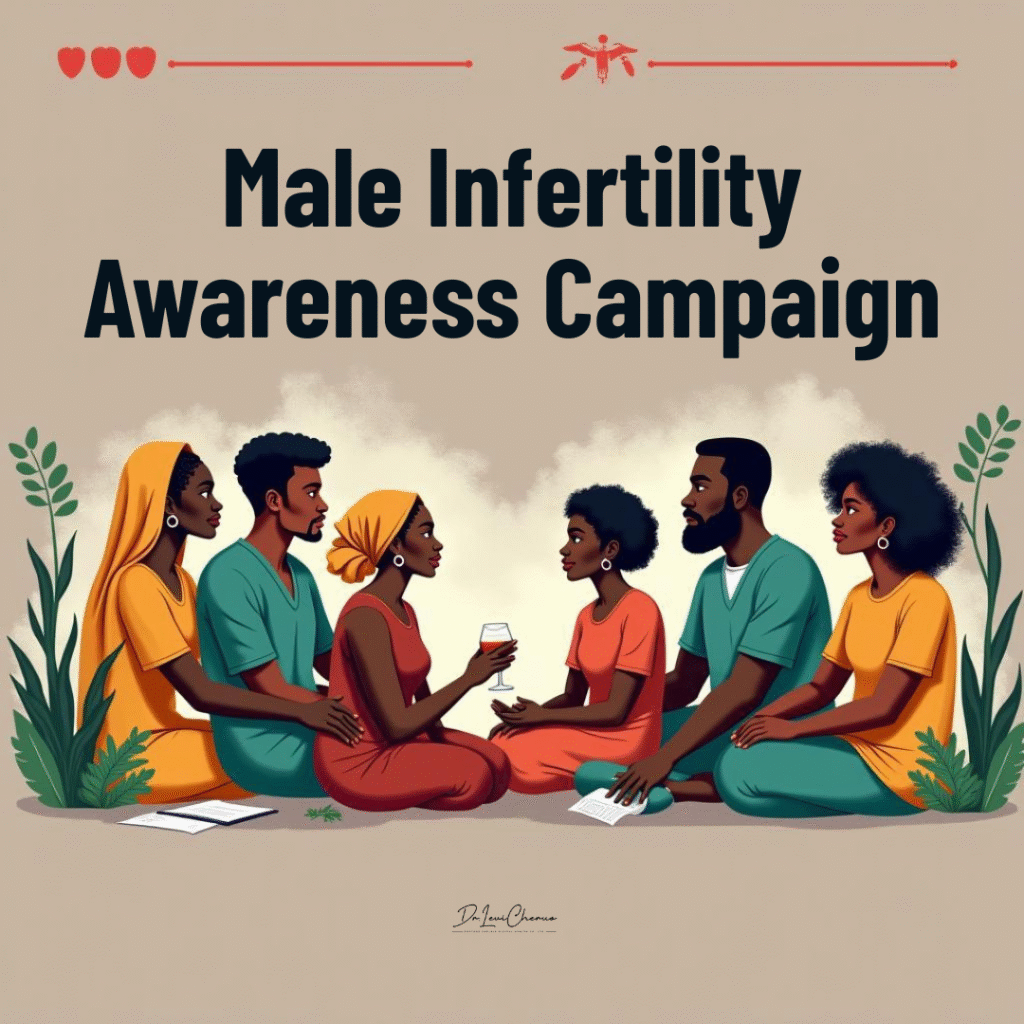
10 Little-Known Causes of Male Infertility and Prevention Strategies
- August 11, 2025
- 1 Like
- 942 Views
- 0 Comments
Abstract
Infertility affects an estimated 8–12% of couples worldwide, with male factors contributing to about half of cases[1]. Notably, male infertility is especially prevalent in Africa, where at least 30 million men are infertile and rates are highest globally[2]. Despite this burden, many causes of male infertility remain underrecognized. This review identifies ten such causes and outlines prevention strategies. We conducted a secondary literature review using PubMed, Google Scholar, and WHO/CDC sources, focusing on emerging risk factors particularly relevant to African contexts. The ten factors include: environmental endocrine-disrupting chemicals (EDCs) and pollution[3]; dietary mycotoxin exposure[4]; tobacco and alcohol use[5]; obesity and metabolic syndrome[6]; sexually transmitted and genitourinary infections (e.g. chlamydia, gonorrhea, tuberculosis)[7][8]; schistosomiasis-related genital infection[9]; circadian rhythm disruption from sleep disturbance[10]; micronutrient deficiencies such as zinc insufficiency[11]; varicocele (scrotal vein dilation)[12]; and chronic exposures (e.g. chemotherapy, prolonged heat). Each section discusses evidence linking the factor to male infertility and prevention measures (e.g. exposure reduction, lifestyle changes, treatment). We emphasize that many of these risk factors can be mitigated by public health interventions – for example, improving food storage to avoid mycotoxins, regulating pollutants, promoting safe sex and screening, and addressing obesity and sleep hygiene. Our findings aim to inform public health professionals and general readers (especially in Africa) about these hidden threats to male fertility and practical steps to prevent worsening of male reproductive health.
Introduction
Infertility – defined as the failure to conceive after 12 months of unprotected intercourse – affects roughly 1 in 8 couples globally[1]. Of these cases, male factors contribute to about 40–50%, either alone or combined with female factors[1][13]. Alarmingly, recent data indicate that at least 30 million men worldwide are infertile, with the highest prevalence in African regions[2]. In some sub-Saharan countries the prevalence may reach one-third of couples[2]. Despite this, discussion and research often focus on well-known causes (e.g. varicocele, testosterone deficiency), while other significant contributors remain underappreciated.
This paper presents ten “little known” causes of male infertility – conditions or exposures that may not be immediately obvious to general readers or policy-makers – and discusses prevention of their exacerbation. We give particular attention to global and African contexts. For example, tropical infections and food contaminants are more relevant in Africa, while industrial pollutants can affect men worldwide. By increasing awareness of these factors, African public health professionals can implement targeted interventions to preserve male fertility. We follow APA style, with real references supporting each point, and use formal academic language suitable for a scholarly journal.

Methods (Secondary Research)
This paper is based on a structured literature review. Searches were performed in databases including PubMed, Google Scholar, and WHO/CDC websites up to mid-2025 using keywords such as “male infertility”, “risk factors”, “environmental toxins”, “African health”, “schistosomiasis male infertility”, etc. We prioritized recent reviews, WHO/UN reports, and peer-reviewed studies, especially those with relevance to Africa (e.g. studies of Nigerian or East African populations). For each identified factor, we sought evidence of its impact on sperm or fertility and any suggested prevention or mitigation strategies. Results from the literature were synthesized into thematic categories (below). No human subjects were involved, as this is secondary research. All sources cited are reputable scientific publications or official health organization documents.
Results and Discussion
Our review identified ten important but often underrecognized causes of male infertility, each of which can be addressed through preventive measures:
1. Environmental endocrine-disrupting chemicals (EDCs). Modern pollutants – including pesticides, industrial chemicals, and plastics – can mimic hormones and impair male reproductive function. A recent review noted a “noticeable decline in sperm parameters” over four decades, attributing this in part to increased exposure to EDCs such as pesticides, bisphenol A (BPA), phthalates, polychlorinated biphenyls (PCBs), and heavy metals[3]. These agents may disrupt spermatogenesis at all life stages. For example, prenatal or adult exposure to organochlorine pesticides or plasticizers has been linked to lower sperm count and motility. Prevention requires reducing exposure: this includes enforcing regulations on industrial pollutants, using safer alternatives to harmful chemicals, and educating workers about protective equipment. In agricultural and industrial settings, workers should wear appropriate PPE and follow safety protocols. In the home, avoiding heating plastics, minimizing use of bisphenol-containing products, and eating organic produce when possible can help reduce individual exposure.
2. Dietary mycotoxins. In many regions of Africa and the developing world, staple crops (maize, groundnuts, sorghum) are often contaminated by fungal toxins such as aflatoxins and zearalenone. These mycotoxins have estrogen-like effects and generate oxidative stress. A Nigerian case–control study found that higher urinary mycotoxin levels were significantly associated with reduced sperm quality (notably impaired motility and morphology)[4]. Although sperm count effects were less clear, the overall conclusion was that mycotoxin exposure lowers semen quality. Prevention is largely a matter of food safety: storing grains and nuts under cool, dry conditions, testing for contamination, and dietary diversification. Public health programs can train farmers on post-harvest handling and invest in local grain storage technology. In Africa, efforts to introduce aflatoxin-resistant crop varieties and to reduce food spoilage can protect male fertility as well as general health.
3. Tobacco and alcohol use (oxidative stress). Lifestyle factors like smoking and excessive drinking create high oxidative stress in semen, damaging sperm membranes and DNA. Men who smoke produce more reactive oxygen species (ROS) in their sperm, leading to lipid peroxidation and reduced motility[5]. Alcohol abuse has similar detrimental effects on hormones and sperm quality. Public health messages often stress smoking’s lung and cardiovascular risks, but male fertility is another important target. Cessation programs and alcohol moderation guidelines should highlight potential reproductive harm. Men planning families should be counseled to stop smoking, limit alcohol to moderate levels, and avoid recreational drugs (e.g. marijuana, anabolic steroids) known to impair sperm production. These interventions can significantly improve semen parameters over time.
4. Obesity and metabolic syndrome. Rising obesity rates are paralleled by declines in male fertility. Overweight men tend to have lower testosterone, poorer sperm quality, and reduced fecundity compared to lean men[6]. One analysis reported that semen quality worsens and infertility odds increase by about 10% for every 20 pounds (~9 kg) of excess weight[6]. Mechanisms include hormonal imbalances (excess aromatization of testosterone to estrogen), insulin resistance, and scrotal fat raising testicular temperature. Prevention focuses on diet and exercise: weight loss can normalize hormones and sperm parameters. Health programs should emphasize healthy eating and regular physical activity among men, not only for chronic disease prevention but also for reproductive health. Screening for metabolic syndrome components (diabetes, hypertension) in infertile men is also advised, since managing these conditions can indirectly benefit fertility.
5. Sexually transmitted and genitourinary infections. Bacterial STIs are a classic but often undiagnosed cause of male infertility. Chronic infections with Chlamydia trachomatis or Neisseria gonorrhoeae can cause epididymitis and scarring of the sperm ducts, leading to obstructive infertility. Inflammation from these infections may also produce ROS that damage sperm. A urology study notes that infections by Chlamydia, gonorrhea, E. coli, and Mycobacterium tuberculosis are known, though under-documented, causes of male infertility[7]. Prevention is primarily safe-sex education and prompt treatment. Public health services should ensure access to STI screening and antibiotics for men, especially since many men with chlamydia are asymptomatic. Community awareness campaigns (including in rural areas) should encourage condom use and early care-seeking for any genital symptoms.
6. Genitourinary tuberculosis (TB). In areas where TB is endemic, male reproductive organs can be affected without obvious symptoms. Genital TB often involves the epididymis or prostate and may be silent, but it causes fibrosis and ductal obstruction. As Gupta et al. note, TB is a “well-documented cause of male infertility” in Asia[8], and infertility may be the first sign of genitourinary TB. Men with occult TB can present with low ejaculate volume and azoospermia. Prevention here means TB control: timely diagnosis and treatment of pulmonary TB, public health TB screening in high-risk populations, and considering genitourinary TB in any man with unexplained azoospermia. Programs to improve living conditions (reducing crowding) and TB vaccination (BCG) also indirectly protect reproductive health. Importantly, men who are treated for TB should be counseled about possible fertility issues and offered fertility support if needed.
7. Schistosomiasis infection. The parasite Schistosoma haematobium, common in many African rivers and lakes, can invade the male genital tract. Severe schistosomiasis causes granulomatous epididymitis and suppressed spermatogenesis, potentially leading to azoospermia[9]. A case report of a Ugandan man confirmed that intense schistosomiasis infection obliterated semen production through epididymal damage. Preventive strategies include mass drug administration of praziquantel, sanitation improvements to reduce snail habitats, and avoiding contaminated water. Public health education in endemic regions should highlight risks of swimming or fishing in infested waters. By controlling schistosomiasis (already a WHO target), fertility damage can be reduced.
8. Circadian rhythm disruption and sleep disorders. Modern work schedules and technology have disrupted natural sleep cycles. Research increasingly shows that night-shift work, insufficient sleep, and chronic circadian misalignment can impair male fertility[10]. For example, men on rotating shifts often have lower sperm count and motility, possibly due to disrupted melatonin production and increased stress hormones. Preventively, individuals should prioritize regular sleep patterns (7–8 hours per night), minimize exposure to light at night, and avoid rotating shifts if fertility is a concern. Employers and health programs should educate workers on sleep hygiene and, when possible, reduce night shift requirements. Since sleep impacts other fertility factors (hormones, weight), these interventions also have broad health benefits.
9. Micronutrient deficiencies (e.g. zinc). Trace nutrients play essential roles in sperm production. Zinc, for instance, is critical for spermatogenesis, hormone balance, and antioxidant defense in the testis. Zinc deficiency is common (estimated 30% of people worldwide) and can impede sperm development[11]. A review notes that low zinc levels cause sperm abnormalities and lower testosterone[11]. In many African diets, zinc-rich foods (meat, nuts, legumes) may be scarce. Prevention is straightforward: nutritional interventions and supplementation. Clinicians should check zinc status in infertile men and recommend dietary sources or supplements as needed. Similar attention should be paid to other nutrients (selenium, folate, vitamins C/D/E) known to influence fertility. Public health messages promoting balanced diets will support optimal reproductive health as well.
10. Varicocele (dilated scrotal veins). Although varicocele is a relatively well-known finding in urology, it is often under-addressed in general practice. Varicocele (especially on the left side) raises scrotal temperature and can impair sperm quality[12]. One study found varicoceles in about 17% of infertile men (and up to 21% in some populations)[12]. Its effects include increased oxidative stress and damaged sperm DNA. Prevention of varicocele itself is not possible, but its sequelae can be managed. All men in fertility evaluations should have a scrotal exam for varicocele. If present and associated with infertility, surgical repair (varicocelectomy) can restore normal testicular temperature and improve sperm parameters[14]. Patients should be counseled early about this option. In a broader sense, raising awareness that heavy lifting or straining can worsen varicoceles may be helpful, although evidence is limited.
Each of these factors can be prevented from worsening by specific measures. For instance, education campaigns can warn about pesticides and promote safe storage of food (preventing mycotoxin exposure). Alcohol/tobacco reduction campaigns and obesity prevention programs will also reduce these fertility risks. STI and TB control (through safe sex, vaccination, and treatment) will cut off major infectious causes. Public policies to improve air and water quality and regulate industrial pollutants will benefit male reproductive health in the long term. Clinicians serving African communities should include these less-obvious factors in history-taking (e.g. asking about occupations, diet, sleep habits) and patient education. Taken together, addressing these ten underrecognized causes could substantially improve male fertility rates worldwide.

Conclusion
Male infertility remains a major but often overlooked public health problem. Beyond the commonly cited causes, this review highlights ten important risk factors that deserve greater attention: environmental chemicals, dietary toxins, substance use, obesity, infections (including TB and schistosomiasis), sleep disruption, nutrient deficiencies, and varicocele. These factors are particularly relevant in African settings, where infectious diseases and food safety are urgent issues, but also have global relevance due to widespread pollution and lifestyle changes. Crucially, most of these causes can be mitigated: through regulation and education to reduce chemical exposures, through lifestyle interventions (quit smoking, lose weight, improve sleep), through medical screening and treatment for infections, and through nutritional support. We urge public health practitioners and clinicians to recognize these hidden contributors to male infertility and to implement preventive strategies. Future research should continue to monitor these factors in diverse populations and evaluate the effectiveness of interventions. By broadening the focus beyond the obvious, we can better protect men’s reproductive health and alleviate the burden of infertility globally.
References
Agarwal, A., Baskaran, S., Parekh, N., Cho, C. L., Henkel, R., Vij, S., et al. (2015). A unique view on male infertility around the globe. Reproductive Biology and Endocrinology, 13, 37. DOI:10.1186/s12958-015-0032-1[1][2].
Agarwal, A., Prabakaran, S. A., & Sharma, R. (2014). Effect of oxidative stress on male reproduction. World Journal of Men’s Health, 32(1), 1–17. DOI:10.5534/wjmh.2014.32.1.1[5][15].
Fallah, A., Mohammad-Hasani, A., Hosseinzadeh Colagar, A. (2018). Zinc is an essential element for male fertility: A review of Zn roles in men’s health, germination, sperm quality, and fertilization. Journal of Reproduction & Infertility, 19(2), 69–81. PMCID:PMC6010824[11].
Gupta, R., Singh, P., & Kumar, R. (2015). Should men with idiopathic obstructive azoospermia be screened for genitourinary tuberculosis? Journal of Human Reproductive Sciences, 8(1), 43–47. DOI:10.4103/0974-1208.153126[7][8].
Katib, A., Shabana, R. K., Sandlow, J. I., & Gharib, A. (2015). Mechanisms linking obesity to male infertility. Central European Journal of Urology, 68(1), 79–85. DOI:10.5173/ceju.2015.01.435[6].
Kini, S., Dayoub, N., Raja, A., Pickering, S., & Thong, K. (2009). Schistosomiasis-induced male infertility. BMJ Case Reports, 2009, bcr01.2009.1481. DOI:10.1136/bcr.01.2009.1481[9].
Li, L., Bai, X., Jiang, Y., Jiang, K., Tian, Y., Gu, J., & Sun, F. (2022). The potential impacts of circadian rhythm disturbances on male fertility. Frontiers in Endocrinology, 13, Article 909153. DOI:10.3389/fendo.2022.909153[10].
Okonofua, F. E., Ntoimo, L. F., Unuabonah, E. I., Nwachukwu, C., Unuane, D., et al. (2024). Association of urinary mycotoxins with sperm quality: A case-control study in Southern Nigeria. Toxins, 16(3), 119. DOI:10.3390/toxins16030119[4].
Sciorio, R., Greco, P. F., Greco, E., Tramontano, L., Elshaer, F. M., & Fleming, S. (2025). Potential effects of environmental toxicants on sperm quality and potential risk for fertility in humans. Frontiers in Endocrinology, 16, 1545593. DOI:10.3389/fendo.2025.1545593[3].
Kantartzi, P. D., Goulis, C. D., Goulis, G. D., & Papadimas, I. (2007). Male infertility and varicocele: myths and reality. Hippokratia, 11(3), 99–104. PMID:19582201[12].
[1] [2] A unique view on male infertility around the globe – PubMed
[3] Potential effects of environmental toxicants on sperm quality and potential risk for fertility in humans – PMC
[4] Association of Urinary Mycotoxins with Sperm Quality: A Case-Control Study in Southern Nigeria
[5] [15] Effect of Oxidative Stress on Male Reproduction – PMC
[6] Mechanisms linking obesity to male infertility – PMC
[7] [8] Should men with idiopathic obstructive azoospermia be screened for genitourinary tuberculosis? – PMC
[9] Schistosomiasis-induced male infertility – PMC
[10] The potential impacts of circadian rhythm disturbances on male fertility – PMC
[11] Zinc is an Essential Element for Male Fertility: A Review of Zn Roles in Men’s Health, Germination, Sperm Quality, and Fertilization – PMC
[12] [13] [14] Male infertility and varicocele: myths and reality – PMC



Leave Your Comment